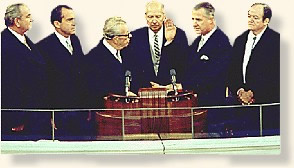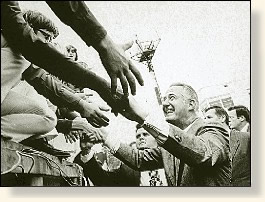|
Payoff to the Vice President, 1971
Spiro Agnew had a meteoric rise to the vice presidency of the United States. He achieved his first public office in 1962 when he was elected chief executive of a suburban Baltimore county. Four years later he was elected Governor of Maryland. In 1968, Richard Nixon tapped him as his running mate. It took only six years for Agnew to rocket from relative obscurity to the second highest office in the land.
 |
Spiro Agnew is sworn in as Vice President
January 20, 1969
|
Agnew's Cinderella story had a dark ending however. After he and Nixon were reelected in 1972, the Vice President came under investigation by the Justice Department for corruption extending back to his days as a county executive. Specifically, he was charged with taking kickbacks from contractors seeking construction work. Agnew vehemently denied all charges but resigned the Vice Presidency on October 10, 1973. He pleaded nolo contendre (no contest) to a single charge of failing to report $29,500 in income he received in 1967. He was fined and placed on three years' probation. Agnew has the dubious distinction of being the first Vice President to depart office with a criminal record.
Lester Matz and John Childs started their Maryland construction company in 1956. Located in Baltimore County, the prospects for their business changed for the better in 1963 when Spiro Agnew took office as County Executive. After an initial meeting with Agnew and a close associate J. Walter Jones, Matz began making payments to Agnew in exchange for receiving county building contracts. The payments equaled 5% of the value of the contract and were always made in cash delivered in an envelope prior to receiving the contract. Matz and Childs contributed significantly to Agnew's 1966 gubernatorial campaign and were rewarded with a continuation of their arraignment with Governor Agnew. The relationship continued when Agnew became Vice President.
Matz and Childs were targeted early on in the Justice Department investigation of Spiro Agnew. The following is excerpted from the Justice Department transcripts of interviews with Lester Matz. Matz describes receiving a phone call from Agnew's associate J. Walter Jones and subsequently delivering a payment to the Vice President in his office:
 |
Agnew during the 1972 campaign
|
"Sometime in 1970, or early 1971, Matz received a telephone call from Jones who advised him that there was an upcoming federal job that the Vice-President would control. This job would generate something in the order of $100,000 in fees, and Jones advised Matz that a payment would be necessary. This job was the (blacked out) and Matz wanted it to go to (blacked out). The job was awarded to (blacked out) He then approached his partner in ( blacked out) for the purpose of advising him that he (Matz) had committed them to make a 5% payment to Mr. Agnew, (blacked out) finally agreed to contribute $1,000. Matz arranged an appointment with Mr. Agnew and Jones in the Vice-President's office in Washington. He then arranged to meet with (blacked out) in Washington just before his appointment with the Vice-President. Matz met with ( blacked out)across the street from the EOB (Executive Office Building) and there received from (blacked out) $1,000 in cash. Matz added $1,500 in cash and placed the entire sum in an envelope which he took with him to his meeting with Jones and the Vice-President. (blacked out) has been interviewed and confirms Matz's recollection of these events. We have the check by which he generated the $1,000.
Matz met with Jones and the Vice-President and placed the envelope on the Vice-President's desk saying that this was the money for the job. By the time Matz left this meeting, neither Jones nor the Vice-President had removed the envelope from the desk.
EOB logs show that Matz met with the Vice-President on April 20, 1971, and this date corresponds with the date on the check that (blacked out) used to generate his share of the payment. To the extent that we understand the EOB logs, however, they do not confirm that Jones met with the Vice-President on this date. (blacked out) is attempting to obtain clarification of some of the documents supplied to us by the Secret service, and we are pursuing the matter."
References:
Cohen, Richard, A Heatbeat Away: the investigation and resignation of Vice President Agnew, (1974); National Archives and Records Administration, Information provided by Lester Matz and John C. Childs filed in the U.S. Attorneys' Records on Spiro T. Agnew (NRBPA-118-1-AGNEW(B).
How To Cite This Article:
"Payoff to the Vice President, 1971," EyeWitness to History, www.eyewitnesstohistory.com (2000).
|






